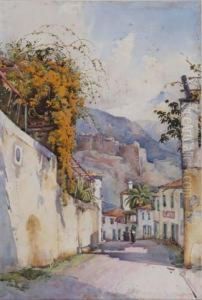Ella Mary Cane Paintings
Ella Mary Cane was an English artist known for her contributions to the arts in the late 19th and early 20th centuries. Born in 1869, Cane's artistic journey began in a period when the role of women in the art world was evolving, yet still faced significant societal constraints. Despite these challenges, she managed to carve out a space for herself and her work, becoming recognized for her delicate watercolors and detailed illustrations. Cane's art often reflected her interest in nature and the countryside, themes that were prevalent in her era among artists who sought refuge and inspiration away from the industrialized urban centers.
Cane's education and early career were marked by her studies at notable art institutions, where she honed her skills in painting and drawing. Her style was influenced by the Arts and Crafts movement, which emphasized traditional craftsmanship and the beauty of nature, principles that resonated with Cane's own artistic sensibilities. Throughout her career, she exhibited her work at various galleries and exhibitions, gaining modest recognition among her peers and the art-loving public.
In addition to her paintings, Cane was also involved in the illustration of books, contributing her talents to the visual storytelling of the time. Her illustrations were characterized by their attention to detail and her ability to capture the essence of the narrative through her artistic interpretation. Despite the limitations often placed upon women in the arts during her lifetime, Ella Mary Cane's work demonstrated her dedication to her craft and her ability to overcome these obstacles through the quality and beauty of her art.
Ella Mary Cane's contributions to the art world continued until her death in 1946. Though not as widely known today as some of her contemporaries, her work remains a testament to her skill and passion for art. Her legacy is preserved through her surviving works, which continue to be appreciated by those who encounter them, offering insight into the artistic landscape of her time and the role of women within it.
